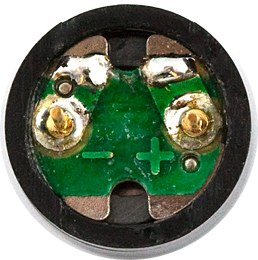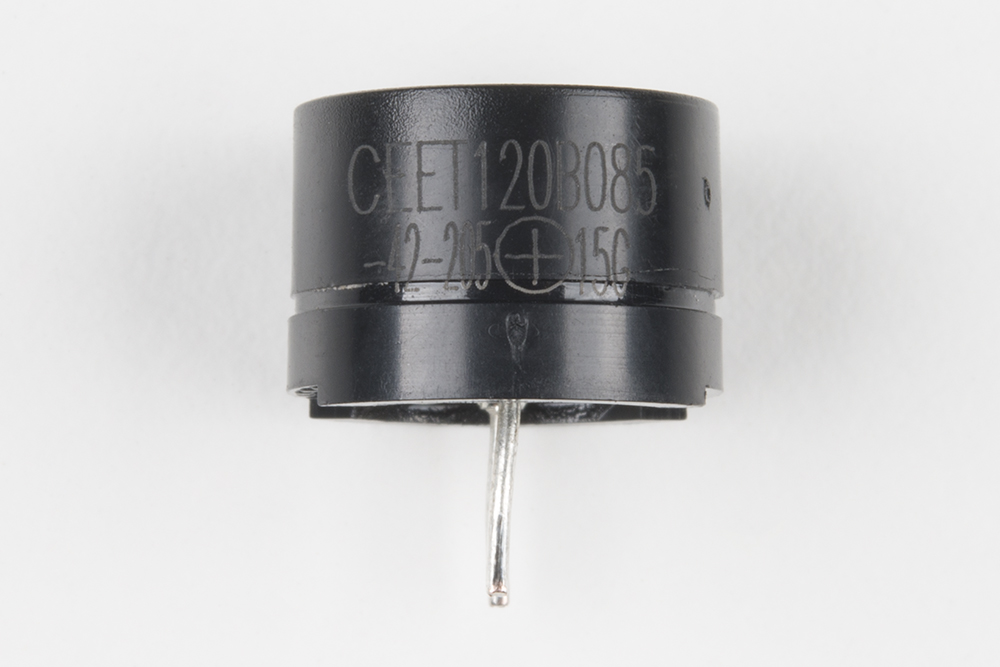(Reference) Speakers / Piezo Buzzers
Speakers / Piezo Buzzers
Piezo Buzzer

Wiring

Wiring: Polarity
- The buzzer will have a + on the bottom or side
+goes to Photon 2 pin capable of PWM-goes to Ground


Operation
- Uses PWM to generate square waves tones up to about 2 KHz
Code: tone()
- The
tone()function produces tones from the buzzer
Syntax
tone(<<PIN>>, <<FREQUENCY>>, <<DURATION>>);
-
tone()generates a square wave using PWM (50% duty cycle) -
pinis connected the speaker -
frequencyis sound frequency in Hz (20Hz to 20KHz) -
durationis the length of tone in milliseconds
Code
Example
const int PIN_SPEAKER = A5;
void setup() {
pinMode(PIN_SPEAKER, OUTPUT);
}
void loop() {
tone(PIN_SPEAKER, 500, 1500); // play 500Hz tone for 1000ms (1 sec)
// delay(1500); // it may be necessary to add equal length delay
}
Optional: Controlling Volume
- It is possible to add a potentiometer which can be used to control the volume of the buzzer. See full class notes on buzzers for more information
tone()requires a pin that supports PWM
Optional: Playing Melodies
Musical Notes
- Musical notes can represented as constants
-
Add this file (pitches.h) to your
srcfolder and then add#include "pitches.h"to your sketch - You can then refer to music notes with constants like
NOTE_C4which is “middle C” on a piano
Musical Note Lengths
- Tone lengths can be represented as musical beats
- Using an array for notes and an array for lengths, you can then create melodies with similar to using musical notation
- You can include can include the musical note
Code
#include "pitches.h" // you need to download this file to your SRC folder
const int PIN_SPEAKER = A5;
// notes in the melody:
int melody[] = {NOTE_C4, NOTE_G3, NOTE_G3, NOTE_A3,
NOTE_G3, 0, NOTE_B3, NOTE_C4};
// note lengths: 4 = quarter note, 8 = eighth note, etc.:
int noteLengths[] = {4, 8, 8, 4, 4, 4, 4, 4};
void setup() {
pinMode(PIN_SPEAKER, OUTPUT);
}
void loop() {
for (int currentNote = 0; currentNote < 8; currentNote++) {
// to calculate the note duration, take one second
// divided by the note type.
// e.g. quarter note = 1000 / 4, eighth note = 1000/8, etc.
int currentNoteLength = 1000 / noteLengths[currentNote];
tone(PIN_SPEAKER, melody[currentNote], currentNoteLength);
// to distinguish the notes, set a minimum time between them.
// the note's duration + 30% seems to work well:
int pauseBetweenNotes = currentNoteLength * 1.30;
delay(pauseBetweenNotes);
}
}
Finding Notes of Popular Songs
- Notes for some popular songs (note that the format for playing notes is different in this code, but you can still extract the notes and duration from these examples)
- MIDI to C converter allows you convert a MIDI file directly into C
Reminder: Photon 2 and tone()
-
tone()requires a pin that supports PWM - Only certain pins support PWM
D1(SCLorA4)A2A5MISO(D16)MOSI(D15)
- All PWM pins on the Photon 2 are assigned to the same timer, meaning you can only generate ONE frequency at a time. In other words, you cannot play different notes with different buzzers at the same time.